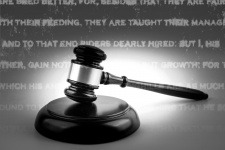How does My Lawyer Prove I was Injured in a Baltimore Car Accident?

Every injury victim in a litigated case has no doubt wondered: “How does My Lawyer Prove I was Injured in a Baltimore Car Accident? In another chapter, I discussed the ‘burden of proof’, i.e. what a Baltimore city personal injury trial lawyer must carry to prove that the defendant is responsible for the accident or injury.

In a typical car accident cases involving negligence principles, this involves proof that the defendant was negligent and caused an accident. But, How does a lawyer prove I was Injured in a Baltimore Car Accident? This is generally presented by testimony of the involved parties, perhaps witnesses, some photographs, and occasionally a video depiction. In a more complex case, perhaps an expert with knowledge of how accidents occur may be brought in to testify. Attorney Eric T. Kirk feels generally, the jury instructions sum up the idea best. Juries are generally told negligence is failing to act as a hypothetical reasonable person in given circumstances.
Burden of Proof in a Baltimore Car Accident Case: Step by Step Guide
When you’re involved in a car accident in Baltimore and seek compensation through a personal injury claim, the legal standard you must meet is known as the burden of proof. This burden determines how much evidence a party must present to prevail. Importantly, this burden varies significantly between civil and criminal cases.
Burden of Proof in a Baltimore Car Accident Case
A car accident claim is a civil case, typically filed in Baltimore City Circuit Court or District Court of Maryland for Baltimore City, depending on the amount in controversy. In this civil context, the injured person—the plaintiff—bears the burden of proof and must convince the judge or jury that the defendant’s negligence caused the accident and resulting damages.
The applicable standard is “preponderance of the evidence.” This means the plaintiff must show that it is more likely than not that the defendant was at fault. It’s often described as proving your case by just 51% certainty. Not all Baltimore fact finders perceive evidence as tilting the scales one way, or another. They are not obligated to. Visualize a set of evenly balanced scales: if the plaintiff’s evidence tips those scales even slightly in their favor, they have met their burden. If you hear language like “my mind is in state of equipoise”, and you are a Plaintiff, this is turning out to be a bad day for you.
In practical terms, this means presenting credible evidence that might include:
- Testimony from eyewitnesses
- Expert accident reconstruction
- Medical records from facilities
- Photographic or video evidence from traffic cameras or phones
Importantly, Maryland follows the doctrine of contributory negligence. If the defendant can prove-by the same standard- that the plaintiff was even 1% at fault for the accident, the plaintiff may be barred from recovery entirely. This makes the burden of proof in Baltimore civil cases particularly exacting for the plaintiff.
Burden of Proof in a Baltimore Criminal Case- What’s different
In contrast, the State of Maryland, through the Office of the State’s Attorney for Baltimore City, prosecutes criminal cases. The burden of proof in a criminal trial is vastly higher: the government must prove the defendant’s guilt “beyond a reasonable doubt.”
This is the highest standard in the legal system. It reflects the principle that the potential consequences—loss of liberty, incarceration, fines—are far more severe than in a civil case. The prosecution must present enough evidence to remove all reasonable doubt in the minds of the jurors. If any reasonable doubt remains, the jury must acquit.
A criminal charge arising from the same event as a car accident—such as DUI or reckless driving—would follow this stricter standard. Civil liability for damages from the accident would still be judged separately under the lower civil burden.
Key Takeaway: Proof Levels Are Not Equal
- Civil (Car Accident): Preponderance of the evidence (more likely than not)
- Criminal: Beyond a reasonable doubt (virtually certain /95% or above)
If you’ve been injured in a Baltimore accident, understanding this difference is crucial. Winning your civil case doesn’t require proving guilt like a prosecutor—it requires demonstrating that the defendant was probably negligent. But even that can be challenging, particularly in a jurisdiction like Baltimore with contributory negligence laws. Moreover, all Baltimore fact finders perceive evidence as tilting the scales in favor of a Plaintiff was being evidence that meets the lesser standard in a civil case. They are not obligated to. If you hear language like “that does not move the meter”, or, ” I know she was hurt, but you have not proven a ‘mechanism of injury’ and you are a Plaintiff, this is turning out to be a bad day for you.
Is it Difficult to Prove I was Injured in a Baltimore Car Accident?
Keep in mind that same burden -a preponderance of the evidence -applies to each and every element of damages claimed. Baltimore jurors in accident and injury cases are instructed that, while an award must be fair, it cannot be based on “guesswork”. Medical records and bills may be used, as well as the testimony of a doctor to explain an injured person’s physical condition. [MPJI 10:1]. Damages must be demonstrated with reasonable certainty. Damages must be more likely than not to occur to be awardable. With some injuries, there might not be objective medical evidence of any abnormality in the Plaintiff’s body. Some injuries, by their nature, are not susceptible to objective verification without conducting tests, the cost of which may be disproportional to the injury. In this scenario, How does My Lawyer Prove I was Injured in a Baltimore Car Accident? In these instances, a judge or Baltimore jury deciding the personal injury case is called upon to determine if they believe or disbelieve, the Plaintiff’s testimony. Over thousands I cases, I have developed some mechanisms to help people convey the nature and extent of their injuries.



